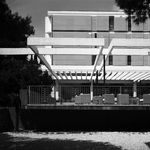Lecture / Constructing an affordable Arcadia
Constructing an affordable Arcadia: modern tourist architecture on the Croatian coast
UGM | Maribor Art Gallery, Strossmayerjeva 6
Thursday, 22 March 2012 at 18.00
lecture by: Maroje Mrduljaš, curator of the exhibition Unfinished modernisations / between utopia and pragmatism
The coast of the former Yugoslavia is distinguished by its natural beauty, pleasant climate and features of cultural interest; it is ideal for the development of tourism. In the mid-1950s began a period of vigorous development aimed partially at the domestic but above all the foreign market. Tourism became an important branch of the economy and the main source of foreign currency for the whole of Yugoslavia. Simultaneously with these processes, there was also the development of the integrated planning, covering urban design and architecture, of holiday-making complexes guided by modernist principles, attention being devoted to the protection of natural resources and controlled building density. Thanks to the systematic development of architectural and planning skills, Yugoslavia was ready to react to the international rise of mass tourism in the 1960s and 1970s, when there was an explanation in the building of tourist capacities. In this period tourist architecture became an area for experimentation and the application of varying morphologies: from the elegant aesthetics of high modernism, via mat-buildings and cellular mega-structures to the integration of architecture and landscape. From 1967 to 1972 large-scale regional plans were made; they were advanced, conceived multi-disciplinarily and worked out in detail. Teams of consultants from eastern and western Europe took part, and the plans were co-financed by the UN. The development of tourist landscapes, on the whole meant for the middle and working classes of western Europe, domestic clients and tourists from countries of the eastern bloc was strategically concentrated on evenly distributed locations, and the coast stayed relatively sparsely built up. The architecture produced during socialism is still the foundation for the tourist industry, the basic planning postulates are legitimate today, and some of the complexes are examples of innovative and graceful architectural agglomerations in the specific genre of building meant for mass holiday-making.
Maroje Mrduljaš (1971, Rijeka) graduated at the Faculty of Architecture in Zagreb. He is the author of numerous exhibited, published and awarded architectural and urban-planning competition projects and studies. He was awarded second prize at the 38th Zagreb Salon in 2003. He publishes essays, outlines and critical texts in the areas of architecture, urban planning, design and visual arts. He is editor of the 'Plan' collection at AGM, member of editorial board of the journals Život Umjetnosti, Up & Underground and Oris. Member of the Croatian section AICA, and autonomous expert of the Mies van der Rohe Award. Employed as a research assistant at the Faculty of Architecture, Zagreb.
FREE ENTRY!
